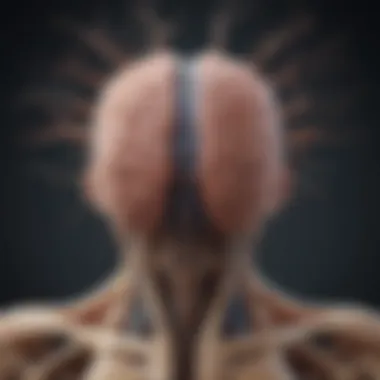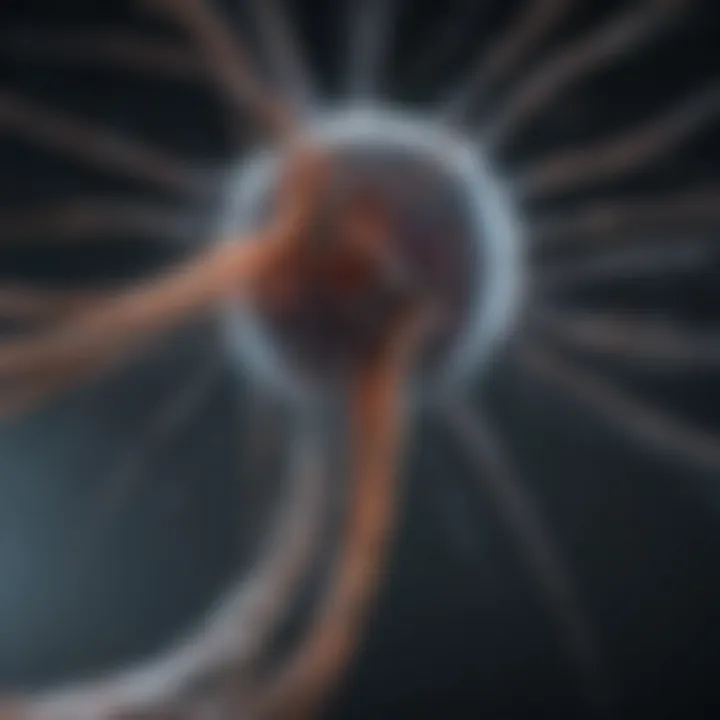Understanding the Functions of the Nervous System


Intro
The nervous system is an incredibly complex and integral part of human biology. Understanding its functions reveals essential insights into how our bodies operate, respond to stimuli, and perform advanced cognitive tasks. This article will explore the primary roles of the nervous system, including sensory perception, coordination of movement, regulation of bodily functions, and advanced cognitive processes.
We will examine the intricate relationship between the central nervous system and peripheral nervous system, focusing on how these components interact to maintain homeostasis and allow for adaptive responses to environmental challenges. Furthermore, this discourse will touch upon physiological implications, health concerns, research developments, and how these factors collectively enhance our understanding of this vital system.
Prologue to the Nervous System
The nervous system is essential for the functioning of the human organism. It serves as the control center, enabling communication between different body parts. Understanding the nervous system provides insights into health, behavior, and cognition. It is vital for education, research, and clinical practices. This article will thoroughly explore the roles and functions of this complex system.
Overview of the Nervous System
The nervous system comprises two main components: the central nervous system and the peripheral nervous system. The central nervous system, which includes the brain and spinal cord, processes information and coordinates actions. The peripheral nervous system connects the CNS to limbs and organs, facilitating communication throughout the body. Each component works in unison to ensure proper body function and response to the environment. Understanding these parts helps identify how they interact to maintain homeostasis.
Importance of Studying the Nervous System
Studying the nervous system is significant for numerous reasons:
- Understanding Disorders: Many neurological conditions such as Alzheimer's disease and Parkinson's disease stem from disturbances in the nervous system. Knowledge in this field aids in diagnosis and treatment.
- Advancements in Technology: Neuroimaging and rehabilitation techniques lead to better patient outcomes. Research in these areas continues to evolve, making it crucial to keep up with new developments.
- Enhancing Cognitive Functions: Insights into the interplay between various brain regions can illuminate ways to improve memory, learning, and emotional regulation.
"The complexity of the nervous system reflects the intricacies of human behavior and thought."
By examining the nervous system closely, professionals can devise strategies for interventions, therapies, and preventative measures, thereby enhancing overall health and quality of life.
Components of the Nervous System
The nervous system is a complex and intricate network critical for the functioning of the human body. Understanding the components of the nervous system is essential for grasping how it influences various functions, from movement to sensation to cognitive processes. This section elaborates on the distinct yet interrelated parts that make up the nervous system, including the Central Nervous System and the Peripheral Nervous System. Each component has its own specific responsibilities and plays a significant role in maintaining bodily functions and overall health.
Central Nervous System
The Central Nervous System (CNS) includes the brain and spinal cord, serving as the main control center for the body. Its structure and function are fundamental to the overall understanding of how the nervous system operates.
Structure of the Brain
The structure of the brain is highly organized, comprising different regions that specialize in various functions. The key characteristic of the brain's structure is its division into lobes: the frontal, parietal, temporal, and occipital lobes. Each lobe has specific responsibilities, from motor functions to sensory processing. This organization is a beneficial aspect to study as it helps explain how complex behavior emerges from neural activity.
One unique feature of the brain's structure is its cortex, which is involved in higher-level functions such as reasoning and problem-solving. Understanding the cortex's role enhances the discourse on cognitive abilities and their physiological basis. However, the brain is also vulnerable to injury, which may disrupt its functions, illustrating both its advantages and disadvantages.
Function of the Spinal Cord
The spinal cord is a critical component of the CNS, functioning primarily as a highway for nerve signals between the brain and the rest of the body. Its primary role is to transmit motor and sensory information; this makes it integral to both voluntary and involuntary functions. The key characteristic of the spinal cord is its segmental organization, with each segment corresponding to different parts of the body.
A unique aspect of the spinal cord's function is its ability to mediate reflex actions, allowing for immediate responses to stimuli without direct involvement from the brain. This ability demonstrates the advantages of spinal reflexes in maintaining homeostasis but can also highlight limitations when injuries occur, affecting movement and sensation.
Peripheral Nervous System
The Peripheral Nervous System (PNS) connects the CNS to limbs and organs. It has two main branches: the somatic nervous system and the autonomic nervous system, each serving different functions.
Somatic Nervous System
The somatic nervous system is responsible for voluntary movements and the relay of sensory information. Its contribution to the overall function of the nervous system is significant, as it facilitates interactions with the environment. A key characteristic of this system is its control over skeletal muscles, allowing for precise movement. This makes it an essential topic within the study of motor function.
One unique feature of the somatic nervous system is its direct connections to muscles. This provides rapid responses to stimuli, highlighting a major advantage in activities requiring agility. However, reliance on conscious control can be a disadvantage in situations where immediate reflex responses are needed.
Autonomic Nervous System
The autonomic nervous system regulates involuntary body functions such as heartbeat and digestion. This system is crucial for maintaining homeostasis. One notable characteristic of the autonomic system is its division into sympathetic and parasympathetic branches, which manage the body's response to stress and relaxation, respectively.
The advantage of the autonomic nervous system lies in its ability to function without conscious effort, ensuring that essential processes keep operating when the body is under stress or at rest. A unique feature is the dual control it offers, which allows for flexibility in responding to varying internal and external conditions. However, dysfunctions in this system can lead to significant health issues, illustrating its critical role in overall well-being.
"Understanding the components of the nervous system provides insights not only into how we function day-to-day but also into potential neurological disorders that can arise when these systems fail."


Through careful study of these components, one gains a deeper appreciation for the delicate balance needed for the nervous system to operate effectively.
Sensory Functions
Sensory functions are vital in the understanding of the nervous system. They allow organisms to perceive the surrounding environment and respond to stimuli. These functions are not merely biological processes; they play a crucial role in shaping experiences and facilitating interactions with the world. In this section, we will explore how sensory neurons contribute to visual, auditory, and tactile experiences. We will also discuss the integration of sensory information, which is essential for effective response and adaptation to our environment.
Role of Sensory Neurons
Sensory neurons are specialized cells responsible for transmitting sensory information to the brain. They play a crucial role in how we understand and interact with our environment. Each type of sensory neuron is equipped to detect specific stimuli, which means they each make unique contributions to the overall sensory experience.
Visual Perception
Visual perception is a fundamental aspect of how we interpret our surroundings. It enables us to recognize faces, objects, and even emotions based on visual cues. The key characteristic of visual perception is its ability to provide spatial awareness and depth perception. Given the dominance of visual information in our lives, this aspect is crucial for communication and navigation.
The unique feature of visual perception lies in its complex processing that begins with the retina in the eye. The retina converts light into electrical signals which are then interpreted by the brain. One advantage is its high resolution; we can perceive fine details. However, visual perception has disadvantages, such as susceptibility to optical illusions, showing that what we see is not always a reflection of reality.
Auditory Processing
Auditory processing allows us to comprehend sounds, which is essential for communication. This includes understanding speech and appreciating music. The key characteristic of auditory processing is its ability to discern frequency and amplitude of sound waves, which helps in identifying the source and meaning of sounds. Given that most people rely on auditory cues in daily life, this ability is particularly beneficial.
A unique feature of auditory processing is its bilateral nature; both ears work together to enhance sound localization. This can be seen as an advantage because it allows for better awareness of the environment. However, auditory processing can be affected by noise pollution, which can impair our ability to focus on specific sounds amid distractions.
Tactile Sensation
Tactile sensation is another critical sensory function and connects us to our physical environment. It involves the perception of touch, pressure, and temperature. The key characteristic of tactile sensation is its immediacy—it provides instant feedback about our interaction with objects or surfaces. Tactile sensations help in many everyday tasks such as writing, typing, and feeling textures.
The unique feature of tactile sensation is the diversity of receptors in the skin that detect different types of stimuli. This variety is advantageous for a rich sensory experience. However, an evident downside can be seen in conditions such as neuropathy, which can alter or impair tactile sensitivity, potentially leading to accidents or injury.
Integration of Sensory Information
Integration of sensory information refers to the brain's capability to combine signals from various sensory modalities. This function allows for a comprehensive understanding of the environment. The brain processes and synthesizes data from sight, sound, and touch, enabling a unified perception. Effective integration is necessary for making accurate decisions and responses. Without this process, perceptions become scattered and less effective in informing behavior.
"The interplay between sensory functions not only enhances our interaction with the world but also shapes our cognitive abilities and emotional responses."
In summary, sensory functions are indispensable in navigating the environment. Understanding these functions helps clarify the complexities of the nervous system and its role in daily life.
Motor Functions
Motor functions play a critical role in the overall functioning of the nervous system. They encompass both voluntary and involuntary movements, enabling organism to interact with their environment effectively. Understanding motor functions is essential, as they directly relate to physical health, coordination, and neurological integrity. This section will explore these functions in depth, highlighting their significance and the mechanisms involved.
Voluntary Movement Control
Voluntary movement control refers to the intentional actions we make, such as walking or writing. This process is critical for daily activities and overall independence.
Motor Cortex and Muscle Coordination
The motor cortex is located in the brain and is responsible for planning, initiating, and executing movements. It sends signals to various muscle groups, ensuring coordinated actions. One key characteristic of the motor cortex is its organized layout, known as the motor homunculus, reflecting different body parts.
This structured representation highlights the precision required in muscle coordination and fine motor skills, making it a prominent aspect in this article. A unique feature of the motor cortex is its ability to adapt through practice, enhancing performance of complex tasks. However, damage to this area can lead to motor deficits, impacting quality of life.
Pathways of Motor Signaling
Pathways of motor signaling consist of neural circuits responsible for transmitting commands from the motor cortex to muscle fibers. These pathways ensure smooth communication and coordination among various body parts. A primary characteristic of motor signaling pathways is their speed. They allow rapid responses during voluntary movements, making them beneficial for activities that require quick reflexes.
This rapid signaling is crucial for athletes and individuals performing precise movements. Moreover, these pathways can be altered through training, improving efficiency of movement. However, they may be affected by conditions such as multiple sclerosis, leading to impaired motor function.
Involuntary Functions
Involuntary functions are actions that occur without conscious control. They are essential for survival, as they manage vital processes automatically. Understanding these functions highlights their underlying mechanisms and importance.
Reflex Arc Mechanisms
Reflex arc mechanisms are neural pathways that mediate reflex actions. When a stimulus triggers a reflex, it bypasses conscious thought, enabling immediate responses. A notable aspect of reflex arcs is their simplicity; they involve a direct connection between sensory and motor neurons. This design allows for swift reactions, making them crucial in emergency situations.


Reflex arcs highlight the nervous system's ability to protect the body from harm, serving as a beneficial focus for this article. A unique feature is their efficiency in response time, which is advantageous during life-threatening scenarios. However, excessive reflex activity can lead to problems like spasms or cramps.
Role of the Autonomic Nervous System
The autonomic nervous system (ANS) regulates involuntary bodily functions, including heart rate, digestion, and respiratory rate. It operates subconsciously, allowing the body to maintain homeostasis and respond to stressors. A key characteristic of the ANS is its division into sympathetic and parasympathetic systems, which govern different responses.
The sympathetic system prepares the body for 'fight or flight', while the parasympathetic system promotes 'rest and digest'. Understanding the balance between these systems is important for understanding health implications and stress management. A unique feature of the ANS is its adaptability in response to various stimuli, ensuring bodily functions are maintained efficiently. However, dysfunction within the ANS can lead to health issues such as anxiety or digestive disorders.
Cognitive Functions
Cognitive functions represent a critical aspect of the nervous system, encompassing the mental processes that influence our ability to think, learn, and remember. These functions play a significant role in shaping how we interact with the world and process information. Understanding cognitive functions in depth helps to illustrate the connections between mental health and neurological activity, offering insights into a variety of conditions that may arise from dysfunction in these areas.
Cognitive functions include several key areas: learning, memory, emotional regulation, and decision-making. Each of these elements is interrelated and contributes to our overall mental acuity and ability to navigate complex social situations. Given the complexity of the nervous system and its influence on these cognitive functions, the implications for education, mental health, and neuroscience research are profound.
Learning and Memory
Learning and memory are foundational components of cognitive functions. Learning processes allow individuals to acquire new information, skills, and experiences. These functions engage various brain regions such as the hippocampus and prefrontal cortex, each contributing to different types of memory. For example, declarative memory is responsible for recalling facts and events, while procedural memory relates to the skills we learn through practice.
Memory, on the other hand, is crucial for the retention and recall of learned information. It enables individuals to form past experiences, allowing for future reference. Memory systems can be categorized as short-term and long-term, each playing distinct roles in cognitive processing.
"Memory is not just a passive storage system but an active process of reconstruction."
Both learning and memory processes can be affected by various factors, including age, health, and environment. Neuroplasticity, the brain's ability to reorganize itself, highlights the capacity for learning throughout life. In educational contexts, understanding how these functions operate can enhance teaching methodologies and promote effective learning environments.
Emotional Regulation
Emotional regulation is another vital cognitive function that greatly impacts personal and social interactions. It involves the ability to monitor, evaluate, and modify emotional reactions in response to internal and external stimuli. This capacity allows individuals to respond to challenging situations with composure rather than impulsivity.
The limbic system, particularly structures like the amygdala and prefrontal cortex, plays a crucial role in emotional regulation. Emotions can influence decision-making and learning, showcasing the interconnected nature of cognitive functions. Effective emotional regulation leads to improved mental well-being, resilience, and better relationship dynamics.
Moreover, challenges in emotional regulation may contribute to various psychological disorders, such as anxiety and depression. Consequently, exploring strategies to enhance this function is essential, given its implications for overall mental health and social functioning.
Decision-Making Processes
Decision-making processes involve evaluating options and making choices based on cognitive assessments. This cognitive function engages the brain in analyzing information, forecasting outcomes, and weighing risks versus rewards. It reflects the ability to integrate knowledge from memory with emotional responses, guiding individuals towards rational or informed choices.
The prefrontal cortex is the brain area most associated with decision-making. This region processes information derived from various neural networks, enabling complex reasoning and judgment. Different factors, such as cognitive biases and emotional states, can impact decision-making effectiveness.
In professional and personal contexts, honing decision-making ability is critical. Better decision-making can lead to improved outcomes in business, health, and personal relationships. Research advancements in understanding the neurological basis of decision-making may foster strategies that enhance this function.
By exploring cognitive functions such as learning, memory, emotional regulation, and decision-making, we gain essential insights into how the nervous system orchestrates behavior and thought processes. This knowledge equates to greater implications for human development, education, mental health, and the future of neuroscience.
Homeostasis and Regulation
Homeostasis is a crucial function of the nervous system, as it maintains the stability of internal environments despite external changes. This regulation ensures that physiological conditions remain within optimal ranges for survival. The nervous system interacts with various other systems, playing an integral role in detecting and responding to any deviations from homeostatic balance. Proper regulation is necessary for health and longevity. Disruption in homeostasis can lead to broad issues, affecting everything from energy levels to emotional states.
Role in Temperature Regulation
Temperature regulation is a prime example of homeostasis managed by the nervous system. The body must maintain a core temperature around 37 degrees Celsius for optimal enzyme function and overall metabolic processes. The hypothalamus acts as the body's thermostat, receiving signals from temperature receptors in the skin and within the body itself.
When the body temperature rises, mechanisms such as perspiration and increased blood flow to the skin activate, dissipating heat to cool the body down. Conversely, if the temperature drops, the body triggers shivering and constricts blood vessels to conserve heat.
- Key points in temperature regulation:
- The hypothalamus plays a central role.
- Skin receptors provide external temperature data.
- Internal receptors monitor core temperature.
This finely tuned balance is essential for physiological function and overall health.
Regulating Hormonal Functions
The nervous system also contributes to the regulation of hormonal functions. Through interactions with the endocrine system, it helps maintain homeostasis by controlling the release of hormones that affect growth, metabolism, and stress responses. For example, the hypothalamus sends signals to the pituitary gland to release hormones that control various bodily functions.
- Important hormonal roles include:


- Growth hormones for development.
- Thyroid hormones for metabolism regulation.
- Adrenaline for fight-or-flight responses.
The synergy between the nervous and endocrine systems highlights the complexity of maintaining stability and adapting to changes in the environment. Understanding these regulatory functions is vital, especially for those researching neurological diseases or endocrinology.
Pathological Conditions Affecting the Nervous System
Understanding the pathological conditions affecting the nervous system is crucial in grasping the full scope of its functions. Diseases and disorders disrupt normal functions and can have serious implications on a person's life. The knowledge of these conditions not only aids in diagnosis and treatment but also helps in fostering a greater understanding of neural biology and its complexities. This section outlines the most prevalent pathological conditions, focusing specifically on neurological disorders and the impact of trauma.
Neurological Disorders
Neurological disorders represent a group of conditions that affect the brain, spinal cord, and nerves. These conditions arise from various causes, ranging from genetics to environmental factors, and they can profoundly influence bodily functions.
Alzheimer’s Disease
Alzheimer's disease is a progressive neurological disorder that leads to memory loss and cognitive decline. One of its key characteristics is the accumulation of amyloid plaques and tau tangles in the brain. These pathological features contribute to the degeneration of neurons, thus resulting in impaired memory and reasoning abilities. Alzheimer's disease is critical to this discussion because it highlights the devastating effects of neurodegeneration on the nervous system.
The unique aspect of Alzheimer’s lies in its gradual progression, which allows for early interventions. Innovations in diagnostic tools and treatment approaches are essential. Understanding this disease adds to the overall narrative of how diseases impact cognitive functions and underscores the importance of research into neurological health.
Parkinson’s Disease
Parkinson’s disease is another significant disorder that impacts the nervous system. It primarily affects movement and coordination due to the loss of dopamine-producing neurons in the brain. A key characteristic of Parkinson's is the presence of motor symptoms, such as tremors and rigidity, which can severely impact daily functioning. This condition is an important focus because it exemplifies the direct relationship between neuronal health and motor control.
One unique feature of Parkinson’s disease is its variability among individuals. Some may experience mild symptoms, while others face more severe challenges. This variability provides valuable insight into how different neural pathways can be affected in similar conditions, making it an important area of study within the pathologies of the nervous system.
Impact of Trauma on Nervous Function
Trauma can also lead to significant alterations in nervous system functions. Physical injuries, such as traumatic brain injuries (TBI), can result in short and long-term dysfunctions that vary greatly among individuals. The impact of trauma can manifest in many ways, including cognitive deficits, emotional disturbances, and variations in sensory perception.
Understanding how trauma affects the nervous system can enhance treatment strategies and rehabilitation efforts. The study of neuroplasticity, which explores the brain's ability to reorganize itself following injury, is particularly relevant. As researchers delve into the complexities of trauma, they can develop more effective therapeutic approaches to mitigate the adverse effects on neural functioning.
Research Advancements in Neuroscience
The field of neuroscience has seen significant advancements in recent years. These developments are crucial for understanding the nervous system's complexities. Research is not just about exploring the structures of the nervous system; it extends to practical applications that influence treatment and rehabilitation. The improvements in both technology and methodology have paved the way for deeper insights and more effective interventions.
Innovations in Neuroimaging
Neuroimaging techniques such as functional magnetic resonance imaging (fMRI) and positron emission tomography (PET) have revolutionized our ability to visualize brain activity. These tools allow researchers to observe real-time changes in brain function. fMRI, for example, provides information about blood flow changes corresponding to neuronal activity. This has led to a better understanding of various brain functions, including perception and cognition.
Some key benefits of these innovations include:
- Increased Accuracy: Neuroimaging offers precise localization of brain functions. This is essential for targeting areas during surgical interventions or assessing traumatic brain injuries.
- Understanding Disorders: Conditions like schizophrenia and depression can be studied effectively with neuroimaging, revealing how brain areas communicate or malfunction.
- Personalized Medicine: These technologies enable tailored treatment approaches, as individual brain responses to therapies can be monitored.
"Neuroimaging has opened a new door for seeing the brain in action, fundamentally changing our understanding of neural function and disorders."
Neuroplasticity and Rehabilitation
Neuroplasticity refers to the brain's ability to reorganize itself by forming new neural connections throughout life. This adaptability is vital for recovery after injuries. Understanding neuroplasticity is integral for developing rehabilitation programs for stroke victims or individuals with traumatic brain injuries. When the nervous system is damaged, other brain areas can sometimes compensate, which is a key factor in rehabilitation strategies.
Here are some considerations regarding neuroplasticity:
- Critical Periods: The brain is particularly adaptable during certain developmental stages, which can be leveraged in therapeutic settings.
- Therapeutic Techniques: Techniques like constraint-induced movement therapy leverage neuroplasticity, encouraging the use of affected limbs and promoting recovery.
- Long-term Effects: Continuous engagement in rehabilitation can strengthen neural pathways cultivated during therapy, enhancing functional recovery.
Closure
The conclusion of this article encapsulates the myriad of functions that the nervous system performs, integrating sensory perception, movement coordination, and cognitive processing into a cohesive framework. Understanding these functions is crucial for several reasons. Firstly, it highlights the complexity of the nervous system and its pivotal role in human health. Any impairment in its functions can lead to significant disruptions, influencing not just motor skills but also cognitive abilities and emotional regulation.
Moreover, recognizing these functions allows for better diagnostics and treatment options for neurological disorders. By shedding light on how the nervous system operates, we can appreciate the delicate balance required for optimal functioning.
Summary of Key Functions
- Sensory Processing: Sensory neurons are responsible for translating external stimuli into neural signals. This allows for the perception of sights, sounds, and physical sensations.
- Motor Control: The nervous system coordinates voluntary and involuntary movements. This includes complex tasks like running or simple reflexes like blinking.
- Cognitive Functions: Higher-order functions such as learning, memory, and decision-making are integral to how individuals interact with their environment.
- Homeostatic Regulation: The system is crucial in maintaining homeostasis. It regulates various biological processes, including temperature, hunger, and hormonal balance.
Understanding these functions can aid in various fields, from medicine to psychology, providing a foundation for further research and practical application.
Future Directions in Neuroscience Research
The field of neuroscience is rapidly evolving. Future research endeavors are likely to focus on several emerging areas:
- Neuroplasticity: Investigating how the brain adapts and changes in response to experiences or injury is crucial. This can lead to innovative rehabilitation strategies for patients with neurological damage.
- Neurodegenerative Diseases: Understanding the mechanisms underlying diseases like Alzheimer’s and Parkinson’s will be essential in developing more effective treatments and interventions.
- Artificial Intelligence in Neuroscience: The intersection of AI and neuroscience could lead to advanced models of brain function, improving diagnostics and personalized medicine.







